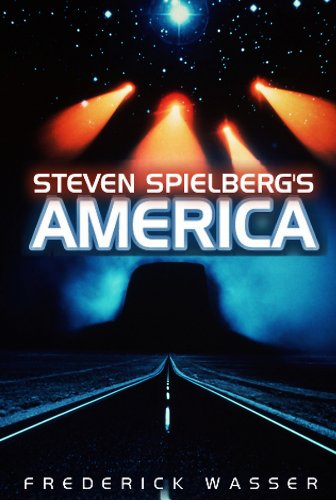
There are tons of books about film and film directors that actually miss the mark, but Fredrick Wasser’s Steven Spielberg’s America gets it completely right. It is one of the best books about one of the best directors of all time. Not only does it explain in great detail Spielberg’s rise in television, but it also talks about the reasons why he would go to become one of the biggest names in film history.
Spielberg redefined the term “blockbuster” with his still heart-pounding summer sensation Jaws (1975); he brought us to tears for life with his masterpiece E.T. The Extra-Terrestrial (1982); and adapted Alice Walker’s Pulitizer Prize-winning novel The Color Purple (1985), which earned 11 Academy Award nominations. In 1993, he terrified and exhilarated audiences with theme-park thriller Jurassic Park and also brought the harrowing Holocaust to life in his Academy Award-winning masterpiece Schindler’s List. In 1998, he made one of the most important and powerful war films of all-time, Saving Private Ryan. His recent triumph was 2013’s Oscar-winning Lincoln, starring Daniel-Day Lewis and Sally Field.
He created his own production company called Amblin and later formed the studio DreamWorks SKG. This is a huge, accomplishing resume, but Spielberg definitely deserves this kind of praise. But, just like us up-and-comers, he was once a USC college student trying to make big break in one of the most intimidating industries, Hollywood.
The first chapter talks about Spielberg’s development, from his birth in Cincinnati, Ohio, to his extreme fascination with cinema. The second chapter is about his first big break, working for Universal. He directed a segment of The Night Gallery called “Eyes,” starring an aging Joan Crawford, then directed the creepy 1971 TV movie Duel, starring Dennis Weaver. Soon, after directing his first feature-length film, the underrated 1974 road movie, The Sugarland Express, with Goldie Hawn, he would go on to make his most popular 70s films, a ‘little known shark attack movie”, named “Jaws”. The third chapter explains the difficulties making Jaws, which would eventually go on become one of the highest grossing movies of all-time, and of course created the summer blockbuster.
The fourth chapter includes the making of E.T., his family blockbuster, which changed the family film forever. The fifth chapter includes his struggles making The Color Purple and Empire of the Sun, while dealing with the rise of the “hard body” action movies starring Stallone and Schwarzenegger that dominated the later part of the 1980s. The sixth chapter includes the historical genre that he would eventually excel in, with not just Schindler’s List and Lincoln, but also Amistad. The seventh and final chapter explains the new decade of hits (Munich) and misses (The Terminal), epics (A.I. Artifical Intelligence), and even remakes (War of the Worlds). The chapter is called “Dark Visions”, and it is truely an ironic title for a chapter.
The last few pages are entitled “Code: Open Questions” and explain how he connected with audiences around the world through his incredible, broad, and distinct depictions of a modern America that we still find ourselves overwhelmed by. It also explains how he is now, and has always been one of the greatest storytellers in movie history. The appendix is a list of his movies and the box-office grosses. It’s amazing how many big hits he has created in his very long career.
If you’re a dedicated film buff or just love Spielberg’s films in general, then you should read this great book. You’ll be hard pressed to find another that is equally detailed about the ups and downs, and ins and outs, and offers very insightful tidbits about Spielberg’s impressive body of work. I’m pretty sure I’ll enjoy it again and again, for many years to come.